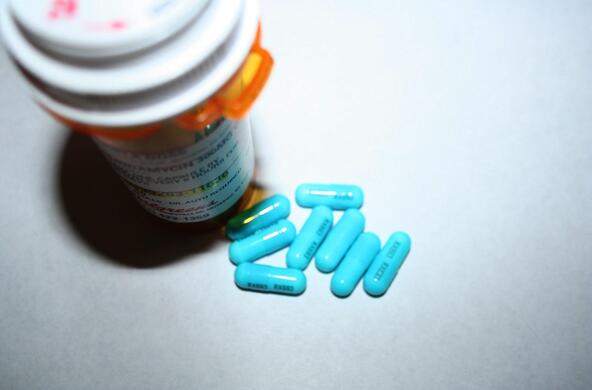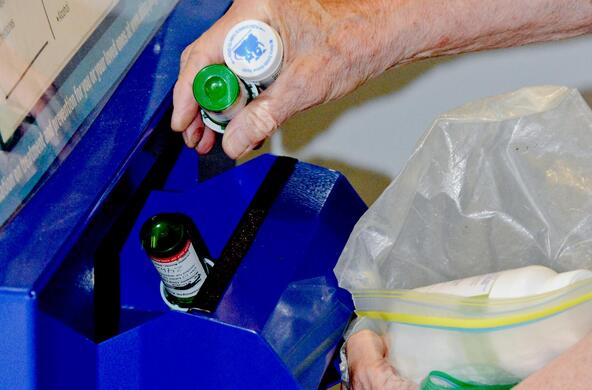In urban streams, persistent pharmaceutical pollution can cause aquatic microbial communities to become resistant to drugs. So reports a new study published today in the journal Ecosphere.
Emma Rosi, an aquatic ecologist at the Cary Institute of Ecosystem Studies and lead author on the study explains, "Wastewater treatment facilities are not equipped to remove many pharmaceutical compounds. We were interested in how stream microorganisms - which perform key ecosystem services like removing nutrients and breaking down leaf litter - respond to pharmaceutical pollution."
Researchers evaluated the presence of pharmaceuticals - including painkillers, stimulants, antihistamines, and antibiotics - in four streams in Baltimore, Maryland. Then they measured the microbial response to drug exposure. Study sites were selected to represent a gradient of development, from suburban to urban.
Microorganisms like bacteria and algae grow in complex assemblages called biofilms - the slimy coatings found on rocks in streambeds. These taxonomically diverse communities are essential to maintaining freshwater health. They drive nutrient cycling, break down contaminants, and form the base of the stream food web.
Rosi notes, "Different types of microbes can withstand different types and concentrations of synthetic chemicals. When we expose streams to pharmaceutical pollution, we are unwittingly altering their microbial communities. Yet little is known about what this means for ecological function and water quality."
The streams analyzed are part of the Baltimore Ecosystem Study, and have well-documented differences in sewage and nutrient contamination. Over a two-week period, passive samplers were deployed in the streams to capture a snapshot of the presence and abundance of six drugs. These included: caffeine and amphetamine (stimulants), acetaminophen and morphine (painkillers), sulfamethoxazole (antibiotic), and diphenhydramine (antihistamine).
Results were clear: urban streams had more pharmaceutical pollution. Compared to their suburban counterparts, they had both a greater number of drugs present, and higher drug concentrations.

Over the same two-week span, the team ran a test exploring how microbial communities in each of the four streams responded to exposure to caffeine, cimetidine, ciprofloxacin, and diphenhydramine. Contaminants were tested singly, with a focus on which microbial species could survive in the presence of the drugs, and how effectively they could function.
Co-author John J. Kelly of Loyola University Chicago explains, "Stream microbial communities are sensitive to pharmaceuticals, which can suppress both respiration and primary production. We used respiration as a proxy to assess microbes' ability to maintain biological function in the presence of pharmaceuticals."
Test jars containing the target pharmaceutical and cellulose sponges, which microbes can readily colonize, were placed in the four streams. Control jars, containing just the cellulose sponges, were placed near the test jars. Fourteen days later, the jars were brought into the lab and analyzed to determine the presence and abundance of microbial species and their respiration rates.
Caffeine, cimetidine, and ciprofloxacin led to a reduction in microbial respiration across all sites; diphenhydramine had a marginal effect. The antibiotic ciprofloxacin had a negative effect on respiration rates, but only in suburban streams. In urban streams, microbial respiration was the same in the drug-exposed and control test jars.
Following drug exposure, the type and abundance of microbial species were different at urban and suburban sites. In urban streams, microbial communities shifted in species composition and were better able to maintain respiration rates. This indicates that these streams harbor resistant microbes that can flourish when non-resistant species can no longer survive.

The type and abundance of pharmaceutical contaminants vary along an urban-to-rural gradient. More developed, urban streams have higher levels of contaminants, and the microbial communities in these streams reflect that history of exposure. Credit: AJ Reisinger
Rosi explains, "We suspect that since urban streams have received frequent pharmaceutical inputs over long timescales, pockets of drug-resistant microbes have developed in these streams. They are ready to colonize substrates, even when drugs are present. When faced with pharmaceutical exposure, these resistant microbes can maintain ecological function, even when other species have been eliminated."
While microbial communities can adapt and thrive in the presence of persistent pharmaceutical inputs, not all microbes are equal in terms of their impact on water quality and human health. For example, bacterial species of the Aeromonas genus, found in the most urbanized stream, are closely associated with human disease and gastrointestinal illness.
Kelly concludes, "Effectively managing our freshwaters requires an understanding of how contaminants, including pharmaceuticals, impact microbial communities. Our findings show that biofilms can be surprisingly resilient. The broader ecological impacts of changes in microbial species composition, as well as the effects of suppressed microbial functioning in more rural streams, remain important questions to explore."
Citation
E. Rosi et al. Urban stream microbial communities show resistance to pharmaceutical exposure. Ecosphere, 2018 DOI: 10.1002/ecs2.2041
This research was partially supported by the U.S. National Science Foundation's Long-Term Ecological Research (LTER) Program. The data in this paper are archived as part of the Baltimore Ecosystem Study LTER.
The Cary Institute of Ecosystem Studies is one of the world's leading independent environmental research organizations. Areas of expertise include disease ecology, forest and freshwater health, climate change, urban ecology, and invasive species. Since 1983, Cary Institute scientists have produced the unbiased research needed to inform effective management and policy decisions.






